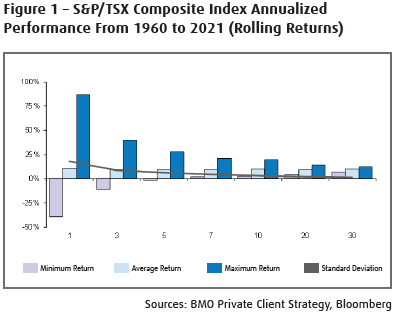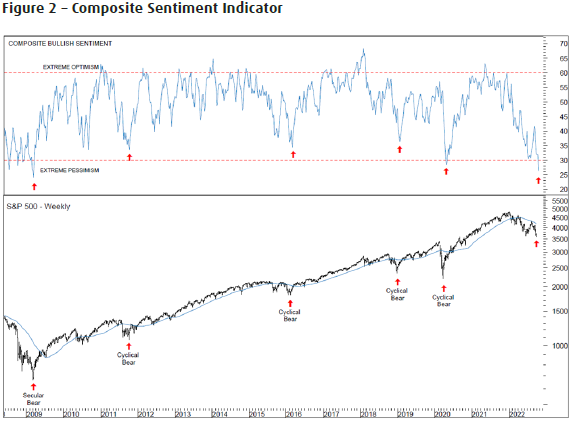
It certainly has felt dark for investors in 2022 with bonds and equities both down double digits – a very rare occurrence indeed. Despite the poor headline numbers, there has been a wide dispersion in performance between geographies, sectors, and equity styles. In fact, the S&P/TSX is down far less (-14%) than the tech heavy Nasdaq (-33%) and the S&P 500 (-25%), the traditional Canadian energy sector is actually up significantly this year (+47%) and value stocks have massively outperformed so called growth stocks.
The point is that there have been and will continue to be places to hide and that investors should be selective in their portfolio choices. For instance, in this environment, we continue to emphasize quality companies with large competitive advantages which provide enough pricing power to offset their cost increases and protect their profit margins. We strongly advise investors to be especially sensitive to valuations (i.e., do not overpay for stocks) as highly valued growth stocks are notoriously sensitive to higher interest rates. While we have advocated being defensive all year long, we are convinced the current market weakness will present a compelling buying opportunity for some beaten down sectors in the not-too-distant future.
While the fear of losing more money is an understandably strong emotion, market history unequivocally tells us that liquidating after a substantial pullback is detrimental to long-term portfolio returns. Looking at over one hundred years of economic history, while the market can be very volatile in any given year, volatility always declines over a longer period of time. To illustrate this point, the following chart shows us that since 1960, the S&P/TSX has never posted a negative return over any rolling 7-, 10-, 20-, or 30-year period.

The blame for financial assets’ weakness year-to-date falls squarely on inflation, associated higher interest rates, and the loss of economic momentum witnessed. Having been painfully slow in recognizing the inflation threat, the fear is that the U.S. and Canadian central banks will commit another monetary policy mistake and raise rates too far too fast, thus engineering a painful economic “hard landing.” But before throwing in the towel on their investments, investors need to appreciate where we came from in terms of valuation levels (which were very high for bonds, housing, and a number of stocks – but are now far more reasonable) and, more importantly, what the prospects are for the year to come. So, how much of the slowdown is now embedded in stock prices? A lot of it in our view. It is critical to remember that the stock market discounts the direction of the economy well ahead of time. Also, historically, relatively mild recessions such as the ones from the early 1980s and 1990s led to approximate 20% declines from peak to trough for the market. Of course, more severe downturns like the “Oil Embargo” recession of 1973 to1975 led to bigger pullbacks but there are several factors which lead us to think that the current slowdown will be far less severe than the 1970s experience and the more recent 2008 Financial Crisis: the resilience of the North American employment market, which is supportive of consumer spending and the strength of corporate balance sheets to name just two.
It is also worth asking how much monetary tightening and inflation have been priced into fixed income markets. Again, we would say a lot. The market anticipates additional tightening of 1.00% to 1.50% (Canada/U.S.) but more importantly, with rapidly rising rates, long-term inflation expectations have trended back towards the 2% target; a clear sign markets believe the strong central bank resolve to tackle inflation will succeed in containing further upside risk and reduce price pressure over time.
Market Technicals
Our Technical Analyst, Russ Visch, notes that while equity markets have come under a great deal of pressure in the past few weeks, we are finally seeing indications in our short- and medium-term timing models that this cyclical bear market is very near to being over. As an example, short-term breadth oscillators were recently more oversold than at any point in decades and sentiment indicators reflect a degree of pessimism that rarely occurs, and only at major bear market lows.
Our Composite Sentiment Indicator is an aggregation of a number of different surveys, which just last week registered its lowest (and therefore most bearish) reading since the credit crisis low in March of 2009. Sentiment gauges are based on the “theory of contrary opinion” which is that at extremes, the crowd tends to do the wrong thing. Fortunately, we can quantify this a bit as well. The last two times stock market participants were this bearish was the credit crisis low in 2009 and the pandemic low in 2020. The average 12-month return for the S&P 500 coming out of those lows was +77.2% and the average 24-month return was +110.7%. It is also important to note that the weak start to 2022 has had no material impact on the secular bull market we’ve been in for the past 8+ years, either. The Dow Jones Industrial Average shows a very clear 32-year cycle that has been playing out for more than 100 years in the Index. If this cycle continues to hold then the bias for equities should be firmly to the upside through the remainder of this decade (i.e., this cyclical bear market will prove to be the best buying opportunity since the pandemic low in March 2020).

While the environment could remain volatile for some time and more downside is possible, the key is to stay disciplined about the price paid for any assets and to maintain a well-diversified portfolio including cash, bonds, and high-quality stocks.
Please contact your BMO Nesbitt Burns Investment Advisor if you would like to discuss your investment portfolio.
The information and opinions in this report were prepared by BMO Nesbitt Burns Inc. Portfolio Advisory Team (“BMO Nesbitt Burns”). This publication is protected by copyright laws. Views or opinions expressed herein may differ from the views and opinions expressed by BMO Capital Markets’ Research Department. No part of this publication or its contents may be copied, downloaded, stored in a retrieval system, further transmitted, or otherwise reproduced, stored, disseminated, transferred or used, in any form or by any means by any third parties, except with the prior written permission of BMO Nesbitt Burns. Any further disclosure or use, distribution, dissemination or copying of this publication, message or any attachment is strictly prohibited. If you have received this report in error, please notify the sender immedi¬ately and delete or destroy this report without reading, copying or forwarding. The opinions, estimates and projections contained in this report are those of BMO Nesbitt Burns as of the date of this report and are subject to change without notice. BMO Nesbitt Burns endeavours to ensure that the contents have been compiled or derived from sources that we believe are reliable and contain information and opinions that are accurate and complete. However, BMO Nesbitt Burns makes no representation or warranty, express or implied, in respect thereof, takes no responsibility for any errors and omissions contained herein and accepts no liability whatsoever for any loss arising from any use of, or reliance on, this report or its contents. Information may be available to BMO Nesbitt Burns or its affiliates that is not reflected in this report. This report is not to be construed as an offer to sell or solicitation of an offer to buy or sell any security. BMO Nesbitt Burns or its affiliates will buy from or sell to customers the securities of issuers mentioned in this report on a principal basis. BMO Nesbitt Burns, its affiliates, officers, directors or employees may have a long or short position in the securities discussed herein, related securities or in options, futures or other derivative instruments based thereon. BMO Nesbitt Burns or its affiliates may act as financial advisor and/or underwriter for the issuers mentioned herein and may receive remuneration for same. Bank of Montreal or its affiliates (“BMO”) has lending arrangements with, or provides other remunerated services to, many issuers covered by BMO Nesbitt Burns’ Portfolio Advisory Team. A significant lending rela¬tionship may exist between BMO and certain of the issuers mentioned herein. BMO Nesbitt Burns Inc. is a wholly owned subsidiary of Bank of Montreal. Dissemination of Reports: BMO Nesbitt Burns Portfolio Advisory Team’s reports are made widely available at the same time to all BMO Nesbitt Burns investment advisors. Additional Matters TO U.S. RESIDENTS: Any U.S. person wishing to effect transactions in any security discussed herein should do so through BMO Capital Markets Corp. (“BMO CM”) and/or BMO Nesbitt Burns Securities Ltd. (“BMO NBSL”) TO U.K. RESIDENTS: The contents hereof are intended solely for the use of, and may only be issued or passed onto, persons described in part VI of the Financial Services and Markets Act 2000 (Financial Promotion) Order 2001. BMO Wealth Management is the brand name for a business group consisting of Bank of Montreal and certain of its affiliates, including BMO Nesbitt Burns Inc., in providing wealth management products and services.
BMO Private Wealth is a brand name for a business group consisting of Bank of Montreal and certain of its affiliates in providing private wealth management products and services. Not all products and services are offered by all legal entities within BMO Private Wealth. Banking services are offered through Bank of Montreal. Investment management, wealth planning, tax planning, and philanthropy planning services are offered through BMO Nesbitt Burns Inc. and BMO Private Investment Counsel Inc. Estate, trust, and custodial services are offered through BMO Trust Company. Insurance services and products are offered through BMO Estate Insurance Advisory Services Inc., a wholly-owned subsidiary of BMO Nesbitt Burns Inc. BMO Private Wealth legal entities do not offer tax advice. If you are already a client of BMO Nesbitt Burns Inc., please contact your Investment Advisor for more information. Nesbitt Burns Inc. is a member of the Canadian Investor Protection Fund and the Investment Industry Regulatory Organization of Canada.
® Registered trademark of Bank of Montreal, used under license.
BMO CM and BMO NBSL are Members of SIPC